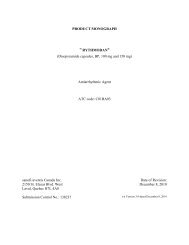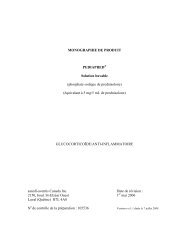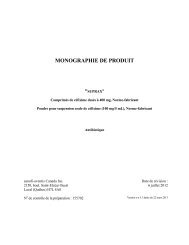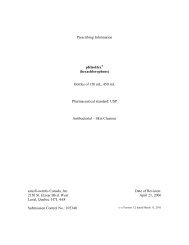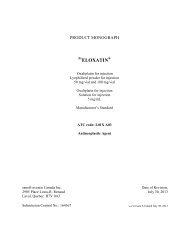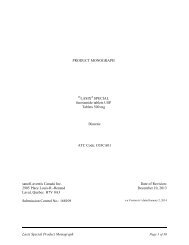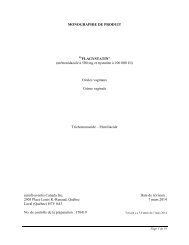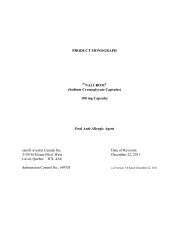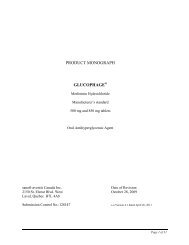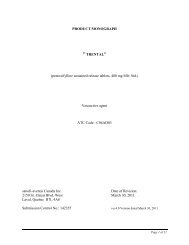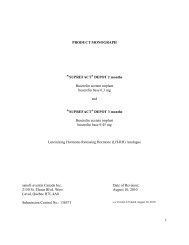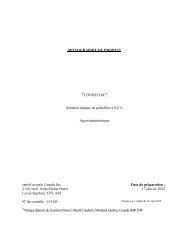Apidra (insulin glulisine) - Sanofi Canada
Apidra (insulin glulisine) - Sanofi Canada
Apidra (insulin glulisine) - Sanofi Canada
Create successful ePaper yourself
Turn your PDF publications into a flip-book with our unique Google optimized e-Paper software.
treatment regimens. No differences between APIDRA and regular human <strong>insulin</strong> groups were<br />
seen in the number of daily injections or basal or short-acting <strong>insulin</strong> doses (see Table 10).<br />
Table 10: Type 2 Diabetes Mellitus–Adult<br />
Treatment duration 26 weeks<br />
Treatment in combination with following basal<br />
<strong>insulin</strong>:<br />
NPH human <strong>insulin</strong><br />
APIDRA Regular Human Insulin<br />
Number of subjects treated<br />
A1c (%)<br />
435 441<br />
Endstudy mean 7.11 7.22<br />
Adjusted mean change from baseline -0.46 -0.30<br />
APIDRA – Regular Human Insulin -0.16<br />
95% CI for Treatment difference<br />
Basal <strong>insulin</strong> dose (U/day)<br />
(-0.26; -0.05)<br />
Endstudy mean 65.34 63.05<br />
Adjusted mean change from baseline<br />
Short-acting <strong>insulin</strong> dose (U/day)<br />
5.73 6.03<br />
Endstudy mean 35.99 36.16<br />
Adjusted mean change from baseline<br />
Severe hypoglycemia*<br />
3.69 5.00<br />
Number of subjects (%) 6/416 (1.4) 5/420 (1.2)<br />
Rate (events/month/patient) 0.00 0.00<br />
Mean number of short-acting <strong>insulin</strong> injections per<br />
day<br />
2.27 2.24<br />
* Events requiring assistance from third party during the last 3 months of the study<br />
CI = Confidence Interval<br />
Pre- and Post-Meal Administration (Type 1 Diabetes):<br />
A 12-week, randomized, open-label, active-control study (n = 860) was conducted in patients<br />
with Type 1 diabetes to assess the safety and efficacy of APIDRA administered at different times<br />
with respect to a meal. APIDRA was administered subcutaneously either within 15 minutes<br />
before a meal or immediately after completing a meal or 20 minutes after starting a meal and<br />
regular human <strong>insulin</strong> was administered subcutaneously 30 to 45 minutes prior to a meal. The<br />
comparisons performed in this study were pre-meal APIDRA compared to regular human<br />
<strong>insulin</strong>, post-meal APIDRA compared to regular human <strong>insulin</strong>, and post-meal APIDRA<br />
compared to pre-meal APIDRA. Insulin glargine was administered once daily at bedtime as the<br />
basal <strong>insulin</strong> in all groups. Before start of the study there was a 4-week run-in period, with<br />
regular human <strong>insulin</strong> and <strong>insulin</strong> glargine followed by randomization. Glycemic control and the<br />
rates of hypoglycemia requiring intervention from a third party were comparable for the<br />
treatment regimens. Significant reductions from baseline in A1c were observed in all three<br />
treatment regimens. No changes from baseline between the treatments were seen in the total<br />
daily number of <strong>insulin</strong> injections. An increase in daily short-acting <strong>insulin</strong> dose was seen with<br />
regular human <strong>insulin</strong> (see Table 11).<br />
Page 31 of 61



